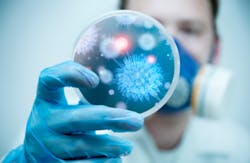BIRMINGHAM — In Water Technology’s Contaminant of the Month featured in the March issue, Technical Editor Dr. Joseph Cotruvo writes about Cryptosporidium and Giardia, Cotruvo discusses what they are, the potential health considerations, available water treatment, analyses and how they are regulated.
Cryptosporidium and Giardia, explains Cotruvo, are the most common protozoa of concern in drinking water sources throughout the U.S.
Cotruvo continues that there are several species of each, and some species can infect humans, and both protozoa are fecal, oral intestinal parasites of many warm-blooded animals.
Exposure and infections of Cryptosporidium and Giardia can occur from coming into contact with contaminated recreational water or from food, and many outbreaks have been reported from drinking water, states Cotruvo.
Of detected organisms in water, approximately 20 percent are infectious, informs Cotruvo, adding that some organisms are not viable, and some of those that are viable are not infectious.
“Infection requires ingestion of about one to 10 organisms,” says Cotruvo. “Some infections are asymptomatic, so some people are not aware they are infected. Symptoms can include diarrhea and sometimes nausea, vomiting and fever. The infections are usually self-limiting, lasting several days for healthy people, but they can be chronic or fatal for less healthy or immunocompromised people.”
In the article, Cotruvo lists available water treatment for Cryptosporidium and Giardia:
- Both survive well in cold water, but Cryptosporidium cysts are very sensitive to water temperature. A 2 log inactivation occurs in 70 days at 20o C, 35 days at 25o C and seven days at 30o C.
- They are more resistant than bacteria to disinfectants; Cryptosporidium is completely resistant to chlorination.
- Conventional drinking water treatment (coagulation, flocculation, sedimentation, filtration, etc.) is effective.
- Chlorine, hypochlorite, chlorine dioxide, ozone and ultraviolet (UV) are effective for Giardia; chlorine dioxide, ozone and UV are effective for Cryptosporidium.
- Microfiltration (MF), ultrafiltration (UF), nanofiltration (NF) and reverse osmosis (RO) are very effective for removing both microorganisms.
- Conservative regulators give limited credit for even RO because of concerns about potential membrane leakage.
- Appropriate POU and POE filters, and UV can remove both microorganisms.
- Boiling of water, as in distillation, is another effective means to kill microorganisms, including Cryptosporidium and Giardia lamblia.
The risks of waterborne diseases have been reduced by drinking water regulations, notes Cotruvo, adding, “Surface water treatment rules require filtration of almost all surface water supplies.”
You can find March’s Contaminant of the Month on Cryptosporidium and Giardia here.


